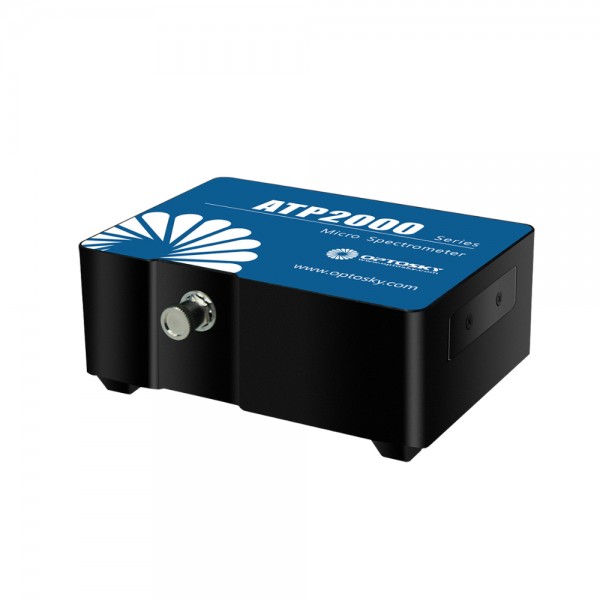ATP2000SH high-speed micro-spectrometer is a low-noise, high-performance, high-speed, miniature fiber optic spectrometer. Its sensor is a 2048 pixel CCD, the CCD signal acquisition frame rate can reach 4Kfps, and the spectral response range is 200- 1000 nm.
ATP2000SH is very suitable for fast detection due to its high A/D converter frequency and high-speed data transmission. In the ATP2000SH memory chip, algorithms for improving performance, such as wavelength calibration coefficients and linear coefficients, are stably programmed. It outputs spectral data to PC via USB 2.0 or RS232 interface. ATP2000SH works with +5VDC power supply provided by USB.
Model | Detector pixels | Whether cooling |
ATP2000SH | 2048pixels | No |
| Detector | |
| Detector type | Linear COMS |
| Effective photosensitive area length | 28.672 mm |
| Spectral range | 200-1100 nm |
| Effective pixels | 2048 |
| Pixels dimension | 14μm×200μm |
| Sensitivity | 1300 V/(lx·s) |
| Dark noise | 13 RMS @ 13°C |
| Optical parameter | |
| Focal distance | 40 mm for incidence / 60 mm for output |
| Optical resolution | 0.1-3 nm (depending on slit, spectral range) |
| Incident Interface | SMA905 connector |
| Signal-to-noise | >450 : 1 |
| Dynamic range | 8.5e7, 2000:1 (single acquisition) |
| Working temperature | -25°c to + 50°c |
| Working humidity | < 90%RH |
| Wavelength range | 200-1100nm(depending on the specific needs) |
| Physical parameters | |
| Dimensions | 102×72×34 mm^3 |
| Weight | 0.2kg |
| Optical configuration | |
| Optical design | F/4 crossed asymmetrical Czerny-Turner |
| Incident slit | 50 μm, other sizes can be customized |
| Electrical parameter | |
| A/D conversion resolution | 16 bits |
| Integration time | 0.2ms-60s |
| Interface | USB 2.0 (high speed) |
| Supply voltage | DC4.5 to 5.5 V (type @5V) |
| Operating current | 170mA |
| Storage temperature | -30°C to +70°C |
| Operating temperature | -25°c to + 50°c |
- Maximum spectral range: 200nm- 1000nm
- Signal acquisition frame rate: ≤ 4672 fps
- Detector: Linear low noise CMOS
- Detector pixels: 2048 pixels
- Spectral resolution: 0. 1-3 nm (depending on spectral range and slit width)
- Optical path structure: cross C-T
- Integration time: 0.2ms-60s
- 20-pin double-row programmable external expansion interface
- Industrial Measurement Sensors
- LED Spectrophotometer
- Fluorescence photometer
- biomedical analyzer
- Transmittance detection
- Reflectivity detection
- UV gas analyzer
- Multi-parameter water quality analyzer
What are Low Cost spectrometer from Optosky?
ATP1XXX & ATP2XXX belongs to low cost spectrometer.
ATP1000 350-1100nm, replace STS
ATP1010 180-1100nm, replace STS and UV enhanced
ATP1012 Xenon lamp driver built-in upgrade from ATP1010
ATP2000P 180-1100nm, higher performance than USB2000+
ATP2000H high speed rate up to 2K or 4K Hz
ATP2002 Xenon lamp driver built-in upgrade from ATP2000P
ATP2100 highest SNR, wave shape can be edited
ATP2110 Water quality analysis spectrometer
ATP2200 180-1100nm, compete with Flame
ATP2400 ultra thin, smaller than USB2000+ performance higher, replace USB2000+
How many topology structure of optical path for a spectrometer?
There are commonly divided into 4 types of optical path, including crossed C-T, M-shape C-T, concave grating optical path, transmittance grating opitcal path.
Crossed C-T: ATP2000P,ATP2002, ATP2400, ATP1010, ATP5020P, ATP5040, ATP6500
M-shape C-T: ATP3030, ATP3034, ATP3330/4 ATP5030, ATP5034, ATP5330/4
Concave grating: ATP4230, ATP4020, ATP4050, ATP4070
let's see the M-shape optical path looks like a number "3", so our models uses the 3rd number "3" to indicate M-shape optical path models.
In generally, topology structure can decide resolution, sensitivity, stray light, and size of a spectrometer.
Crossed C-T topology structure employs better sensitivity and compact size.
M-shape C-T employs higher resolution and better stray light.
Concave grating optical path employs high stray light.
Which modular spectrometer can replace Ocean Insight FLAME-S-VIS-NIR-ES?
Optosky ATP2000 have same performance as Ocean Insight FLAME-S-VIS-NIR-ES, with integration time 1ms-65s, 2048 pixels.








